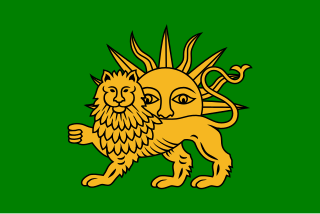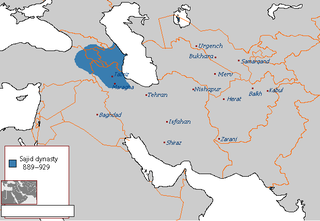Related Research Articles

The Safavid dynasty was one of Iran's most significant ruling dynasties reigning from 1501 to 1736. Their rule is often considered the beginning of modern Iranian history, as well as one of the gunpowder empires. The Safavid Shāh Ismā'īl I established the Twelver denomination of Shīʿa Islam as the official religion of the Persian Empire, marking one of the most important turning points in the history of Islam. The Safavid dynasty had its origin in the Safavid order of Sufism, which was established in the city of Ardabil in the Iranian Azerbaijan region. It was an Iranian dynasty of Kurdish origin, but during their rule they intermarried with Turkoman, Georgian, Circassian, and Pontic Greek dignitaries, nevertheless they were Turkic-speaking and Turkified. From their base in Ardabil, the Safavids established control over parts of Greater Iran and reasserted the Iranian identity of the region, thus becoming the first native dynasty since the Sasanian Empire to establish a national state officially known as Iran.

The Saffarid dynasty was a Persianate dynasty of eastern Iranian origin that ruled over parts of Persia, Greater Khorasan, and eastern Makran from 861 to 1002. One of the first indigenous Persian dynasties to emerge after the Islamic conquest, the Saffarid dynasty was part of the Iranian Intermezzo. The dynasty's founder was Ya'qub bin Laith as-Saffar, who was born in 840 in a small town called Karnin (Qarnin), which was located east of Zaranj and west of Bost, in what is now Afghanistan. A native of Sistan and a local ayyār, Ya'qub worked as a coppersmith (ṣaffār) before becoming a warlord. He seized control of the Sistan region and began conquering most of Iran and Afghanistan, as well as parts of Pakistan, Tajikistan and Uzbekistan.

Maragheh is a city in the Central District of Maragheh County, East Azerbaijan province, Iran, and serves as capital of both the county and the district.

Ya'qūb ibn al-Layth al-Saffār, was a coppersmith and the founder of the Saffarid dynasty of Sistan, with its capital at Zaranj. Under his military leadership, he conquered much of the eastern portions of Greater Iran consisting of modern-day Iran, Afghanistan, Turkmenistan, Uzbekistan, Tajikistan as well as portions of western Pakistan and a small part of Iraq. He was succeeded by his brother, Amr ibn al-Layth.

Abhar is a city in the Central District of Abhar County, Zanjan province, Iran, and serves as capital of the county.

Mazyar was an Iranian prince from the Qarinvand dynasty, who was the ruler (ispahbadh) of the mountainous region of Tabaristan from 825/6 to 839. For his resistance to the Abbasid Caliphate, Mazyar is considered one of the national heroes of Iran by twentieth-century Iranian nationalist historiography. His name means "protected by the yazata of the moon".

Abū Ibrāhīm Ismā'īl ibn-i Aḥmad-i Sāmāni, better known simply as Ismail-i Samani, and also known as Isma'il ibn-i Ahmad, was the Samanid amir of Transoxiana (892–907) and Khorasan (900–907). His reign saw the emergence of the Samanids as a powerful force. He was the son of Ahmad ibn-i Asad and a descendant of Saman Khuda, the eponymous ancestor of the Samanid dynasty who renounced Zoroastrianism and embraced Islam.

Alid dynasties of northern Iran or Alavids. In the 9th–10th centuries, the northern Iranian regions of Tabaristan, Daylam and Gilan, sandwiched between the Caspian Sea and the Alborz range, came under the rule of a number of Arab Alid dynasties, espousing the Zaydi branch of Shia Islam.

Amr ibn al-Layth or Amr-i Laith Saffari was the second ruler of the Saffarid dynasty of Iran from 879 to 901. He was the son of a whitesmith and the younger brother of the dynasty's founder, Ya'qub ibn al-Layth al-Saffar.

Abu'l-Hasan Tahir ibn Muhammad ibn Amr was amir of the Saffarid amirate from 901 until 909. He was the son of Muhammad ibn Amr.

The Sajid dynasty, was an Iranian Muslim dynasty that ruled from 889/890 until 929. The Sajids ruled Azerbaijan and parts of Armenia first from Maragha and Barda and then from Ardabil. The Sajids originated from the Central Asian province of Ushrusana and were of Iranian (Sogdian) descent. Muhammad ibn Abi'l-Saj Diwdad the son of Diwdad, the first Sajid ruler of Azerbaijan, was appointed as its ruler in 889 or 890. Muhammad's father Abu'l-Saj Devdad had fought under the Ushrusanan prince Afshin Khaydar during the latter's final campaign against the rebel Babak Khorramdin in Azerbaijan, and later served the caliphs. Toward the end of the 9th century, as the central authority of the Abbasid Caliphate weakened, Muhammad was able to form a virtually independent state. Much of the Sajids' energies were spent in attempting to take control of neighboring Armenia. The dynasty ended with the death of Abu'l-Musafir al-Fath in 929.
Muhammad ibn Abi'l-Saj also known as Muhammad al-Afshin, an Iranian appointed general of al-Mu'tadid, He was the founder of Sajid dynasty and governor of Azerbaijan, from 889 or 890 until his death. He was the son of Abi'l-Saj Devdad.

Yusuf ibn Abi'l Saj was the Sajid amir of Azerbaijan from 901 until his death. He was the son of Abi'l-Saj Devdad.
Abu'l-Sāj Dēvdād was a Sogdian prince, who was of the most prominent emirs, commanders and officials of the Abbasid Caliphate. He was the eponymous ancestor of the Sajid dynasty of Azerbaijan. His father was named Devdasht.
Abi'l-Saj may refer to:
Abu 'l-Fadl Muhammad ibn Abi Abdallah al-Husayn ibn Muhammad al-Katib, commonly known after his father as Ibn al-'Amid was a Persian statesman who served as the vizier of the Buyid ruler Rukn al-Dawla for thirty years, from 940 until his death in 970. His son, Abu'l-Fath Ali ibn Muhammad, also called Ibn al-'Amid, succeeded him in his office.

Abū Muḥammad al-Ḥasan ibn ʿAlī ibn al-Ḥasan ibn ʿAlī ibn ʿUmar al-Ashraf ibn ʿAlī Zayn al-ʿĀbidīn, better known as al-Ḥasan al-Uṭrūsh, was an Alid missionary of the Zaydi Shia sect who re-established Zaydi rule over the province of Tabaristan in northern Iran in 914, after fourteen years of Samanid rule. He ruled Tabaristan until his death under the regnal name of al-Nāṣir liʾl-Ḥaqq, and became known as al-Nāṣir al-Kabīr to distinguish him from his descendants who bore the same surname. He is still known and recognized as an imam among the Zaydis of Yemen.
Abd-Allah Mikali was an Iranian statesman from the Mikalid family, who served the Saffarids, and later the Abbasids.
There is an incomplete list of governors of Azerbaijan, a region in northwestern Iran.
References
- Madelung, W. (1975). "The Minor Dynasties of Northern Iran". In Frye, R.N. (ed.). The Cambridge History of Iran, Volume 4: From the Arab Invasion to the Saljuqs. Cambridge: Cambridge University Press. pp. 198–249. ISBN 978-0-521-20093-6.